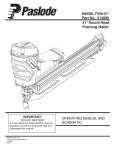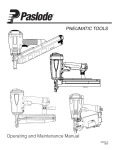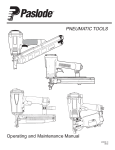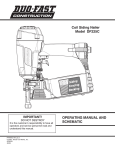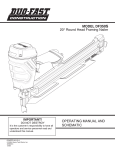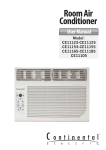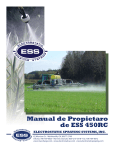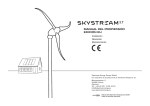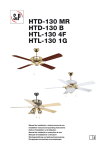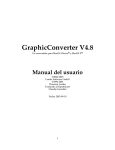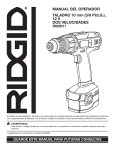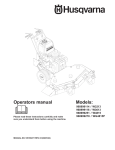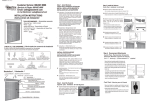Download Paslode 513000 Use and Care Manual
Transcript
MODEL F325R Framing Nailer IMPORTANT! OPERATING MANUAL AND SCHEMATIC DO NOT DESTROY It is the customers responsibility to have all operators and service personnel read and understand this manual. PRINTED IN U.S.A. © 2014, Illinois Tool Works Inc. 513057-1 03/14 1 INTRODUCTION The Paslode® F325R remodeling framing nailer is a quality-built tool designed for use in residential framing applications. This tool will deliver efficient, dependable performance when used according to the manufactures guidelines. Please study this manual including the safety instructions to fully understand the operation of this tool. TOOL AND FASTENER SPECIFICATIONS ................................................................. 3 SAFETY INSTRUCTIONS ............................................................................................ 4 TOOL INSTALLATION AND OPERATION ................................................................ 5-6 AIR SYSTEMS ............................................................................................................. 7-8 FEATURES AND BENEFITS .......................................................................................... 9 EXPLODED VIEW AND SPARE PARTS LIST ....................................................... 10-11 MAINTENANCE ........................................................................................................ 12-13 TROUBLESHOOTING .................................................................................................. 14 WARRANTY .................................................................................................................. 15 ACCESSORIES ........................................................................................................... 16 2 TOOL AND FASTENER SPECIFICATIONS TOOL SPECIFICATIONS MODEL NO. F325R (Part# 513000) HEIGHT 12.9” WIDTH 4.3" LENGTH 12.3" WEIGHT 5.9 lbs. OPERATING PRESSURE 90 to 120 p.s.i. (6.2 to 8.3 bar) MAGAZINE TYPE 30 degree, Single Strip FASTENER SPECIFICATIONS NAIL LENGTH SHANK DIAMETER 2” - 3-1/4" .113 - .131 TOOL AIR FITTINGS: This tool uses a 3/8” N.P.T. male plug. The tting must be capable of discharging tool air pressure when disconnected from the air supply. OPERATING AIR PRESSURE: 90 to120 p.s.i. (6.2 to 8.3 bar). Select the operating air pressure within this range for best tool performance. DO NOT EXCEED THIS RECOMMENDED OPERATING PRESSURE. 3 SAFETY INSTRUCTIONS SAFETY FIRST These safety instructions provide information necessary for safe operation of Paslode® framing tools. DO NOT ATTEMPT TO OPERATE THE TOOL UNTIL YOU READ AND UNDERSTAND ALL SAFETY PRECAUTIONS AND MANUAL INSTRUCTIONS. DISCONNECT THE TOOL WHEN NOT IN USE Always disconnect the tool from the air line when it is not in use, when you leave the work area or when moving the tool to a new location. The tool must never be left unattended because people who are not familiar with the tool might handle it and injure themselves or others. WEAR EYE AND HEARING PROTECTION Always wear hearing and eye protection devices, that conform to ANSI Z87.1 requirements, when operating or working in the vicinity of a tool. As an employer you are responsible for enforcing the use of eye protection. Wear hard hats in environments that require their use. CARRY THE TOOL ONLY BY THE HANDLE Always carry the tool by the handle only. Never carry the tool by the air hose or with the trigger depressed since you could drive a fastener unintentionally and injure yourself or someone else. THE TOOL MUST BE USED ONLY FOR THE PURPOSE FOR WHICH IT WAS DESIGNED Do not throw the tool on the floor, strike the housing in any way or use the tool as a hammer to knock material into place. DO NOT WEAKEN THE TOOL HOUSING The tool housing is a pressure vessel and should never be weakened by having your companyʼs name, area of work or anything else stamped or engraved into its surface. NEVER ENGAGE IN HORSEPLAY WITH THE TOOL The tool is not a toy so do not use it like one. Never engage in horseplay with the tool or point it at yourself or any other person, even if you think it is not loaded. DISCONNECT THE TOOL WHEN PERFORMING REPAIRS AND CLEARING JAMS Never attempt to clear a jam or repair a tool unless you have disconnected the tool from the air line and removed all remaining fasteners from the tool. NEVER ASSUME THE TOOL IS EMPTY Check the magazine for fasteners that may be left in the tool. Even if you think the tool is empty or disconnected, never point it at anyone or yourself. Unseen fasteners could fire from the tool. ALWAYS USE THE PROPER FITTING FOR THE TOOL Only MALE pneumatic type air connectors should be fitted to the tool, so that high pressure air in the tool is vented to atmosphere as soon as the air line is disconnected. NEVER install FEMALE quick disconnect couplings on the tool. Female couplings will trap high pressure air in the tool when the air line is disconnected, leaving the tool charged and able to drive at least one fastener. NEVER CLAMP THE TRIGGER IN A LOCKED OR OPERATING POSITION The trigger of the tool must never be tampered with, disabled or clamped in a locked or operating position since this will cause the tool to drive a fastener any time the work contacting element depressed. DO NOT EXCEED THE MAXIMUM RECOMMENDED AIR PRESSURE Operate the tool only at the recommended air pressure. Do not exceed the maximum air pressure marked on the tool. Be sure the air pressure gauge is operating properly and check it at least twice a day. DO NOT LOAD FASTENERS WITH THE AIR LINE CONNECTED, OR WITH THE TOOL TRIGGER OR WORK CONTACTING ELEMENT DEPRESSED When loading fasteners into the tool be sure you disconnect the air line and that you do not depress the trigger or work contacting element. Never use any bottled air or gases such as oxygen to operate the tool since they could cause the tool to OPERATE THE TOOL ONLY ON A WORKPIECE The tool should be operated only when it is in contact with the workpiece. Even then you should be careful when fastening thin material or working near the edges and corners of the workpiece since the fasteners may drive through or away from the workpiece. explode. INSPECT TOOL FOR PROPER OPERATION Clean the tool at least daily and lubricate as required. Never operate a dirty or malfunctioning tool. USE ONLY PASLODE ® RECOMMENDED PARTS AND FASTENERS Use only parts and fasteners specifically designed and recommended by Paslode® for use in the tool and for and for work to be done. Using unauthorized parts and fasteners or modifying the tool in any way creates dangerous situations. Replace all missing warning labels---refer to tool schematic for correct placement and part number. DO NOT DISABLE OR REMOVE THE WORK CONTACTING ELEMENT This tool is equipped with a safety mechanism, called a work contacting element, to help prevent accidental accidental firing. Never tamper with, disable or remove the work contacting element. Do not use the tool unless the work contacting element is working properly. The tool could fire unexpectedly. WARNING Failure to follow any of the above instructions could result in severe personal injury to tool user and bystanders or cause damage to tool and property. 4 TOOL INSTALLATION TOOL OPERATION Depth of Drive Adjustment Your Paslode tool comes ready for immediate use and can be installed by following these steps: ® 1. SAFETY - All tool operators and their immediate supervisors must become familiar with the operator safety instructions before operating the tool. The instructions are on page 4 of this manual. The depth of drive adjustment can be adjusted two ways. 1. One way is to adjust the air supply to provide enough drive to meet the proper depth for the application without exceeding manufactures recommended operating pressure of 120 PSI. 2. Included with each tool are one copy of this Safety and Maintenance manual and one copy of the Tool Schematic. Keep these publications for future reference. An ownership registration card is also included. This card must be completed and returned to Paslode immediately to register your ownership. Tools with a Depth of Drive Adjustment ® 2. The depth of drive adjustment is made by turning the thumbwheel on the work contact element. If the tool is overdriving (the fastener head is driven below the work surface), the work contact element should be moved downward. If the fasteners stand up (the head not flush with the surface), the work contact element should be moved up. 3. The plastic cap in the air inlet of the tool must be removed before the male fitting is installed. The tting must be a male pneumatic type that discharges the air from the tool when the air line is disconnected. 4. Install a filter/regulator/lubricator unit, with a gauge as close as practical to the tool, preferably within ten feet. Refer to the Air Systems section of this manual for air hose requirements and lengths. In general, no other special installation is required. Adjust the work contact element until the fastener head depth meets job requirements. 5. If the operator is working at a bench or table, it is usually best to run the air line underneath the bench. A small tray under the benchtop can hold the fastener supply and the tool when not in use. 6. If this tool does not work when it is first connected, do not try to make repairs. Call your Paslode representative immediately. ROTATE THUMBWHEEL IN EITHER DIRECTION ® WORK CONTACT ELEMENT (On tools equipped with this feature) 5 TOOL OPERATION continued Loading of Nails Step 1 - Grasp the handle firmly. Step 2 - Insert one strip of nails into the rear of the magazine. Step 3 - Pull the follower to the rear of the magazine until it is engaged behind the nails. Sequential Operation The sequential operating kit prevents succesive or "bounce" driving. Depress the work contacting element and hold it against the work surface before pulling the trigger. After each fastener is driven, completely release the trigger and lift the tool from the work surface. Switching the Trigger The tool is manufactured with a trigger that can be switched from sequential operation to a bounce drive operation. The trigger is placed in the sequential operating position when the tool was manufactured. To switch the trigger to the bounce operating position, remove the O-ring and trigger pivot pin from the trigger assembly. Move the trigger to the bounce operation position and install the trigger pivot pin and O-ring. The postion indicator on the tool should now be pointing to the as shown in the illustration. Sequential drive position Precision Placement Driving ■ Grasp the tool handle firmly and place the bottom of the work contacting element firmly against the workpiece until it is completely depressed. ■ Squeeze the trigger to drive the fastener. ■ Lift the tool from the workpiece. Pivot pin and o-ring ■ Repeat the procedure for the next fastener. Successive (Bounce) Driving Position indicator ■ Grasp the handle firmly. Bounce drive position ■ Squeeze the trigger and move the tool along the workpiece with a bouncing motion, depressing the work contacting element at the points where you want to insert a fastener. ■ Keep the trigger depressed and continue to bounce the work contacing element against the workpiece, positioning the tool above as carefully as possible. ■ When the desired number of fasteners have been driven, release the tool trigger to avoid unintentional fastener discharge. 6 AIR SYSTEMS Air hoses are not longer than 150 feet. For air-powered tools to work their best, the air supply system must be properly installed and maintained regularly. A drawing in this section shows a properly installed air supply system. Handy checklists for installing and maintaining air supply systems follow. The air system is lubricated regularly. A regular maintenance program is followed. Indoor Air System Installation -Be certain that: Filter/Regulator/Lubricator Units Filter/regulator/lubricator units that can supply enough air and protection for Paslode® tools must meet the following specifications: All pipes supplying air have a large enough inside diameter to ensure adequate air supply. The main supply pipe slopes down, away from the compressor (1/16 inch per foot). Minimum 3/8 inch NPT port size . 50 micron or fine filters. Air storage is provided along lengthy air lines. Regulated pressure from zero to 120 psi. Pipe line branch outlets are at the top of the main pipe line. Lubricators designed for low or changing airflow. Cutoff valves are provided at each branch pipe line throughout the system. Water legs extend from the bottom of each branch line. A refrigerant-type dryer is installed on the system. Air hoses are kept as short as practical. A regular maintenance program is followed. Outdoor Air System Installation -Be certain that: A moisture trap and a filter/regulator/lubricator are installed at the compressor. Air hoses and fittings are large enough so that air flow is not restricted. Minimum hose size is 3/8 inch ID with 1/2 inch ID hose used for any application over 25 feet. 7 AIR SYSTEMS - Continued Calculating Compressor Size Use the air consumption chart in the Tool Schematic for each tool when calculating the operating requirements for the tools. Paslode® tools are designed to operate efficently between 90 and 120 psi and should never be operated at pressure greater than 120 psi. The air consumption chart will help you find the correct compressor size for your application that will quickly replenish tool air pressure. To use the chart you will need to know how many tools will be used and approximately how many fasteners will be driven each minute by each tool on the line. Using the equation: Number of tools X average fasteners/minute/ tool X 1.2 (safety factor) X air consumption (scfm) @ pressure* (psi) = scfm required. We can use the following example: 10 tools X 30 fasteners/minute/tool X 1.2 X 0.051scfm* (@100psi) = 18.36 scfm. *This number is found in the air consumption chart. In this example, using the air consumption chart we find that a compressor providing at least 19 scfm of air is required. Because in compressors approximately 1 hp is required to produce 4 scfm, a compressor of at least 5 hp is required. AIR CONSUMPTION-SCFM/FASTENER AIR CONSUMPTION CHART Calculated Required Piping For example, given a 20 hp electric compressor supplying approximately 80 cfm of air at 120 psi and a main supply pipe length of 350 feet, we see by the table the minimum main pipe inside diameter required for this application is 1-1/4 inch. LENGTH OF RUN (FT.) VOLUME OF AIR (CFM) 50-200 30-60 1 1 1¼ 1½ 1½ 60-100 1 1¼ 1¼ 2 2 100-200 1¼ 1½ 2 2¼ 2½ 200-500 2 2½ 3 3½ 3½ 500-1000 2½ 3 3½ 4 4½ 290-500 500-1000 1000-2500 2500-5000 NOMINAL PIPE DIAMETER (IN.) Pneumatic System Maintenance - Be certain that: • Pneumatic ttings are tight and do not leak. and ensure that automatic draining systems are operating correctly. • Air lines are cleared to prevent freezing, especially in winter. • Lubricator operation is checked regularly and ensure it has an adequate supply of lubricant. .060 ER RT F RE HA L C OO IC O T N T AT I EM H C S .055 .050 .040 .035 .030 60 70 80 90 100 110 AIR PRESSURE-PSIG • Only regulated air is being used and that each regulator is operating properly. 120 8 F325R FEATURES & BENEFITS Nonslip No-Mar Protection Tool-Less Depth of Drive Prevents scratches of interior work surfaces and prevents the tool from sliding on smooth surfaces Provides precise control of nail depth (on other side) Metal Exhaust Cap For maximun durability. Aggressive Work Contact Grabs the wood when toe nailing. Dual Mode Trigger Lock Out Switches from sequential to bounce fire. Eliminates blank firing. Ultra Lightweight Design Bypass Follower Easy to manuever with less arm fatigue. For fast 2-step loading. Compact Design Able to get into tight spots Rear Load Magazine Holds 1 strip or appoximately 41 nails plus lockout. End Plug Left/Right Rafter Hook Accommodates left-or righthanded operators. 9 F325R , 513000 PARTS LEGEND 1 2 3 4 5 * 6 * 7 * 8 * 9 10 * 11 * 12 13 14 15 16 17 * 18 * 19 20 * 21 * 22 * 23 24 25 26 27 28 29 30 31 32 33 34 35 * 36 37 38 511943 511444 511847 408302 513003 511413 513042 201756 202398 511960 539676 511876 511719 1011802 511799 511411 511409 511410 511970 511407 511447 511576 511585 511448 502050 404361 502046 502049 502061 502036 502047 513002 502058 502333 502324 502042 511713 502033 1 1 4 6 1 1 1 1 1 1 1 1 1 1 1 1 1 1 1 1 1 1 1 1 1 1 1 1 1 1 1 1 2 2 1 1 1 1 Nut, Nylon-insert 1/4”-28 Air Deflector S.H.C.S. #10-24 x 1” Flat Washer Top Cap Top Cap Gasket Valve Spring, Main O-Ring, Post O-Ring, Cap Poppet O-Ring, Internal Poppet O-Ring, External Poppet Exhaust Seal Flat Washer S.H.C.S.1/4-28 x 1-9/16” Piston “K” Seal Sleeve Check Valve Band O-Ring, Inner Flange Sleeve Flange O-Ring, Outer Flange * * * * * Bumper Driver Blade Seal Compression Spring Detent Body Roll Pin 1/8 x 1/2” Upper Work Contact Element Ball Detent Compression Spring Thumbwheel Assembly Lower Work Contact Element Housing with Grip Housing Label Roll Pin 1/8 x 1-1/2” Trigger Pin O-Ring Roll Pin 3/16 x 1-3/8” Work Contact Element Guide * ** Denotes Normal Wear Items. Make sure Warning Label (513092) is properly affixed. Replace if necessary. Label available at no charge through the Service Parts Dept. ➔ Denotes New Change AIR CONSUMPTION - SCF/FASTENER * ** 39 40 41 42 43 44 45 46 47 48 49 50 51 52 53 54 55 56 57 58 59 60 61 62 63 64 65 66 67 68 69 70 71 72 73 74 75 76 513066 502014 002187 511714 197913 502044 502059 196345 1015358 511446 502043 092747 502060 502040 511145 091866 502332 502345 402963 513005 502336 502019 502021 511118 500627 502020 403796 511196 513092 442681 502193 513016 513059 502017 404325 502029 502031 502038 1 2 4 4 1 1 1 1 1 1 1 1 1 1 1 1 1 1 1 1 2 1 1 1 1 1 1 1 1 2 1 2 1 2 2 1 1 1 Nose Assembly with Isolators Magazine Isolator 1/4” Lockwasher S.H.C.S. 1/4-20 x 7/8” O-Ring Upper Trigger Valve Spool Compression Spring O-Ring O-Ring Valve Pin Assembly Lower Trigger Valve Spool O-Ring Compression Spring Trip Lever Dual ModeTrigger Roll Pin 1/8 x 3/4” Rafter Hook S.H.C.S. 5/16-18 x 5/8” O-Ring End Plug S.H.C.S. #10-24 x 1” Follower Claw Lockout Bar Follower Body S.H.C.S. 8-32 x 1/2” Compression Spring Roll Pin 1/8 x 1-1/4” Negator Drum/Spring Assembly Warning Label Lock Nut 1/4-20 Actuation Settings Label Magazine Wear Rods Magazine Assembly B.H.C.S. 1/4-20 x 3/4” Stop Nut 8-32 Magazine End Cap B.H.C.S. #8-32 x 1/2” B.H.C.S. #8-32 x 1” SAFETY INSTRUCTIONS WEAR EYE AND HEARING PROTECTION Always wear hearing protection and eye protection devices, including side shields when operating or working in the vicinity of a tool. DO NOT EXCEED MAXIMUM • RECOMMENDED AIR PRESSURE .090 SCF Operate the tool using only the recommended air pressure. Do not exceed the maximum air pressure marked on the tool. Be sure the air pressure gauge is operating properly and check it at least twice a day. Never use any bottled air or gases such as oxygen to operate the tool since they could cause the tool to explode. AIR PRESSURE - PSIG 10 F325R 513000 Piston Assembly 513008 1 2 55 56 16 3 70 # 120 # 59 58 57 65 # 32 4 4 5 34 35 36 37 33 6 7 Main Valve Assembly 511465 8 9 24 38 40 25 51 52 26 ➔ 11 12 Note: Install check band with thick side down. 28 29 30 21 130 # Nose Assembly 513066 41 42 200 # 74 22 31 66 Magazine Assembly 513059 65 69 68 23 62 63 73 15 # 75 76 67 72 64 61 Trigger Assembly 513061 54 27 20 14 Trigger Valve Assembly 511460 53 19 13 60 43 44 45 46 47 49 48 50 39 18 10 15 17 Upper WCE Assembly 502734 20 # Follower Body Assembly 513068 71 70 120 # # Torque Values IN-LBS 11 MAINTENANCE ❑ Open the drain on the air compressor tank to drain any moisture at least daily in extremely cold or humid weather. A few ounces of anti-freeze in the tank will keep the air free of frost. Paslode® tools are built for ease of maintenance. A few simple details will assure trouble-free operation and long tool life. Anyone who uses or maintains the tool must read the safety and maintenance instructions. Study the schematic drawing before starting any repairs on the tool. Testing the Tool After Servicing After replacing any part or parts, it is important to check the tool for proper operation. This ensures that the tool was put together correctly, is safe to use, and will perform the job properly. Air-operated tools must be inspected periodically, and worn or broken parts must be replaced to keep the tool operating safely and efficiently. Also the items on the maintenance chart must be checked often. ❑ Ensure that all hardware is tight. ❑ Ensure that the work contacting element is installed correctly in relation to the trigger, and that both parts move freely. Cold Weather Care When temperatures are below freezing, tools should be kept warm by any convenient, safe method. If this is not possible, the following procedure should be used to warm up the tools. ❑ Ensure that the magazine is properly attached. ❑ Ensure that the required safety information on the tool is legible. ❑ Reduce the regulated air pressure to 30 psi. ❑ Use only Paslode® approved fasteners in the tool, and ensure that they are correct for the application. ❑ Remove all fasteners from the tool. ❑ Collect an air line and blank fire the tool. The reduced air pressure will be enough to free-fire the tool. Slow speed operation tends to warm up the moving parts. Slowing up the piston helps the bumper and the O-rings to become springy. ❑ Ensure that a male air fitting is securely connected to the tool. ❑ Test the tool by driving fasteners into a workpiece identical to the tool's application. ❑ Check the tool for air leaks during testing and for the proper sequence of operation. ❑ Ensure that all fasteners are driven to the same depth and that the crown of the fastener is flush with the workpiece. ❑ Once the tool is warmed up, readjust the regulator to the proper working pressure and reload the tool. Tool Lubrication ❑ Tool operators working outdoors or in unheated areas in It is most important that the tool be properly lubricated by keeping the air line lubricator filled and correctly adjusted. Without proper lubrication the tool will not work properly and parts will wear prematurely. Use the proper lubricant in the air line lubricator. The lubricator should be of low air flow or changing air flow type, and should be kept filled to the correct level. Use only Paslodeʼs recommended lubricants. Substitutes may harm the rubber compounds in the tools O-rings and other rubber parts. Part No. 403720 is a pneumatic lubricanting oil specially made for pneumatic applications. If a filter/regulator/lubricator is not installed on the air system, air operated tools should be lubricated at least once a day with 6 to 20 drops of oil, depending on the work environment, directly through the male fitting in the tool housing. Most minor problems can be resolved quickly and easily using the maintenance table that follows. If problems persist, contact your Paslode® dealer for assistance. extremely cold temperatures should also: Use pneumatic oil with antifreeze in the lubricator, Part No. 219090 (8oz.) Once a week, depending on the amount of tool use, take the tool apart and wash away any sludge with tool cleaner ( Part No. 219348) to keep the tool operating efficently. Cleaning the air-operated tools with solvents removes the thin coating of grease applied to the cylinder wall and O-rings at the factory. To replace this coating of grease, use Chemplex grease (Part No. 403734). 12 MAINTENANCE - Continued CAUTION Disconnect the tool when performing repairs or clearing jams. MAINTENANCE TABLE ACTION WHY HOW Drain air line filter(daily). Prevent accumulation of mositure and dirt. Open manual petcock (most air supply systems have such a valve). Keep lubricator filled. Keep tool lubricated. Fill with pneumatic tool lubricant. Part No. 403720. Clean filter element-then blow air through filter in direction opposite to normal flow. Prevent clogging of filter with dirt. Wash with soap and water or follow manufacturers instructions. Check that all screws on tool are tight. Prevent air leakage and promote efficient operation. Check screws daily. Keep work contacting elelment working properly. Promote operator safety and efficient tool operation. Blow clean daily. Keep magazine and feeder mechanism clean. Prevent jamming of fasteners. Blow clean daily. Lubricate "O" rings that are replaced. Assure long life and proper operation of tool. Use Chemplex grease, Part No. 403734. Use only Paslode® replacement parts. Keep tool operating efficiently and maintain Paslode® tool warranty. Order any repacement parts needed from your local Paslode® Dealer. 13 OPERATOR TROUBLESHOOTING CAUTION Disconnect the tool when performing repairs or clearing jams. PROBLEM CORRECTIVE ACTION Adjust work contacting element (retract length). Fasteners will not drive completely into wood. Increase air pressure (do not exceed 120 psi). Increase air flow to tool -- use larger air lines (3/8 inch ID minimum). Fasteners penetrate properly during normal operation, but won't drive fully at faster speeds. Reduce air pressure. Fasteners drive too deeply into wood. Adjust work contacting element (extend length). Check magazine for proper fasteners. Magazine follower should slide freely. Clean as needed to remove debris. Tools skips during operation - no fasteners are driven from time to time. Make sure correct fasteners are being used. Use fasteners that meet Paslode specifications only. Increase air flow to tool -- use larger air lines (3/8 ID minimum). Adjust work contacting element where available. Check magazine for proper fasteners. Fasteners should slide freely with no follower pressure. Tool operates, but no fasteners are driven. Increase air pressure (do not exceed 120psi). Tighten cap screws. Air leaks at cap when tool is connected to air. 14 14 TOOL WARRANTY An Illinois Tool Works Company 888 Forest Edge Drive Vernon Hills, Illinois 60061 MODEL F325R Framing Nailer TOOL WARRANTY AND LIMITATIONS Paslode® warrants that newly purchased power fastening tools, parts and accessories will be free from defects in material and workmanship for the period shown below, after the date of delivery to the original user. ONE-YEAR LIMITED WARRANTY A one-year warranty will apply to all parts, except those which are specifically covered by an extended warranty. FIVE-YEAR EXTENDED LIMITED WARRANTY A ve-year warranty will apply to all housing and cap assembly castings. WARRANTY STATEMENT This warranty is limited to tools sold and service requested in the United States. To obtain information on warranty service in the United States, refer to the Service Center listing that was provided with your tool. Paslode's sole liability hereunder will be to replace any part or accessory which proves to be defective within the speci c time period. Any replacement part or accessory provided in accordance with this warranty will carry a warranty for the balance of the period of warranty applicable to the part it replaces. This warranty does not apply to part replacement required due to normal wear. This warranty is void as to any tool which has been subjected to misuse, abuse, accidental or intentional damage, use with fasteners, not meeting Paslodeʼs specification, size, or quality, improperly maintained, repaired with other than genuine Paslode® replacement parts, damaged in transit or handling, or which, in Paslodeʼs opinion, has been altered or, repaired in a way that affects or detracts from the performance of the tool. PASLODE® MAKES NO WARRANTY, EXPRESSED OR IMPLIED, RELATING TO MERCHANTABILITY, FITNESS, OR OTHERWISE, EXCEPT AS STATED ABOVE, AND PASLODEʼs LIABILITY AS STATED ABOVE AND AS ASSUMED ABOVE is in lieu of all other warranties arising out of, or in connection with, the use and performance of the tool, except to the extent otherwise provided by applicable law. PASLODE® SHALL IN NO EVENT BE LIABLE FOR ANY DIRECT, INDIRECT,OR CONSEQUENTIAL DAMAGES, INCLUDING, BUT NOT LIMITED TO, DAMAGES WHICH MAY ARISE FROM LOSS OF ANTICIPATED PROFITS OR PRODUCTION, SPOILAGE OF MATERIALS, INCREASED COST OF OPERATION, OR OTHERWISE. Paslode® reserves the right to change specifications, equipment, or designs at any time without notice and without incurring obligation. 15 ACCESSORIES Lubricants and Loctite Loctite 242 (Blue) .20 oz. Lubricating Oil 16 oz. Lubricating Oil with Antifreeze 8 oz. Chemplex 710 Lubricant 1lb. Part No. Part No. Part No. Part No. 093500 403720 219090 403734 Tool Cleaner Ideal cleaner for all Paslode ® tools in a 12 oz. aerosol can. Safety Glasses Part No. 219348 Clear Part No. 401382 No Mar Work Contact Part No. 502234 For technical support call 1-800-222-6990. To purchase parts and accessories, visit www.itwconstructionparts.com. An Illinois Tool Works Company 888 Forest Edge Drive Vernon Hills, Illinois 60061-3105 ACESORIOS Lubricantes Y Loctite Loctite 242 (Azul ) Acetite Lubricante 16 oz. Acetite Lubricante 8 oz . Lubricante Chemplex 710 1lb. Pieza No. Pieza No. Pieza No. Pieza No. 093500 403720 219090 403734 Limpiador El limpiador ideal para todas las herramientas Lentes de Seguridad Claros Pieza No. 219348 Pieza No. 401382 Kit de reparación de parte de F325R Pieza No. 219389 Contacto de elemento "no-mar" Pieza No. 502234 Para llamada técnica de apoyo, 1-800-222-6990. Para comprar las partes y los accesorios, la visita www.itwconstructionparts.com. PRINTED IN U.S.A. © 2014, Illinois Tool Works Inc. An Illinois Tool Works Company 888 Forest Edge Drive Vernon Hills, Illinois 60061-3105 GARANTÍA An Illinois Tool Works Company 888 Forest Edge Drive Vernon Hills, Illinois 60061 TERMINOS DE LA GARANTÍA Paslode ® garantías que sus herramientas mecánicas, sus piezas y accesorios, que hayan sido comprados nuevos, están libres de defectos de material y fabricación por el período indicado más abajo, a partir de la fecha de compra del comprador original. Paslode ® asume únicamente la responsabilidad de reponer cualquier pieza o accesorio que se compruebe pruebe como defectuoso dentro del período especificado. Cualquier pieza o accesorio de repuesto, entregado de conformidad con esta garantía, gozará de la garantía por el período restante de la garantía que cubría a la pieza o al accesorio originales. Esta garantía no cubre las piezas que necesitan ser repuestas como consecuencia de su desgaste normal. GARANTÍA LIMITADA DE UN AÑO La garantía limitada de un año cubre todas las piezas, con excepción de aquellas cubiertas por la extención de garantía. Se cancelará esta garantía a cualquier herramienta que haya sido usada incorrectamente, dañada accidental o intencionalmente, usada con sujetadores que no reúnan las especificaciones, el tamaño o la calidad de Paslode ® o a la que no se le haya dado el man tenimiento o el uso adecuado, o que haya sido reparada con piezas que no sean marca Paslode ® o que en opinión de Paslode ® hayan sido modificadas o reparadas de manera que afecte o sea contraria al funcionamiento de la herrmienta. GARANTÍA LIMITADA ADICIONAL DE CINCO AÑOS La garantía de cinco años cubre todos los armazones y ensambles de las tapas. PASLODE ® NO OTORGA NINGUNA GARANTÍA EXPLÍCITA O IMPLÍCITA CON RESPECTO A LA COMERCIALIZACIÓN O ADAPTACIÓN AL USO PREVISTO, O DE CUALQUIER OTRA NATURALEZA, CON EXCEPCIÓN DE LO DECLARADO ANTERIORMENTE, y la responsabilidad de PASLODE ® TAL COMO SE INDICA Y SE ASUME MÁS ARRIBA reemplaza a todas las otras garantías que resulten o estén relacionadas con el uso y funcionamiento de la herramienta mienta, excepto según lo estipulen las leyes pertinentes. PASLODE ® NO SERÁ RESPONSABLE EN NINGÚN CASO POR NINGÚN DAÑO DIRECTO, INDIRECTO O CONSECUENTE INCLUYENDO, PERO SIN LIMITARSE, CUALQUIER DAÑO RESULTADO DE LA PÉRDIDA DE PRODUCCIÓN O GANAN CIAS ANTICIPADAS, EL DETERIORO DE MATERIALES, AUMENTOS EN EL COSTO DE OPERACIÓN O CUALQUIER OTRO. DECLARACIÓN DE LA GARANTÍA Esta garantía esta limitada a las herramientas vendidas y revisadas en los Estados Unidos. Para obtener mas información sobre el servicio de garantía en los Estados Unido, véa la lista de Centros de Servicio que fue proporcionada con su herramienta. Paslode se reserva el derecho de cambiar las especificaciones, el equipo o los diseños en cualquier momento, sin aviso previo y sin incurrir en obligación alguna. 15 DETECCION Y CORRECCION DE FALLAS PRECAUCIÓN Desconecte la herramienta al hacer cualquier reparación o eliminar cualquier obstrucción. PROBLEMA SOLUCIÓN Los sujetadores no penetran completamente en la madera. Cambie la posición del elemento de contacto (Retraiga la longitud). Aumente la presión de aire (no debe exceder 120 psi). Los sujetadores penetran bien durante las operaciones normales, pero fallan a velocidades más altas. Aumente el flujo de aire a la herramienta; use líneas de aire más grandes (3/8” de diámetro como mínimo). Los sujetadores penetran demasiado en la madera. Cambie la posición del elemento de contacto (Extienda la longitud). Reduzca la presión de aire. Los sujetadores se acumulan en la punta de la herramienta. Abra el seguro delantero, quite el sujetador obstruido y cierre bien el segurro. La herramienta “salta” mientras está funcionando; de vez en cuando no impulsa sujetadores. Compruebe si el cargador tiene los sujetadores apropiados. El transportador debe deslizarse sin dificultad. Límpielo para quitar cualquier suciedad. Verifique que se usen los sujetadores apropiados. Use solamente sujetadores que reúnan las especificaciones de Paslode®. Aumente el flujo de aire a la herramienta; use líneas de aire más grandes (3/8” de diámetro como mínimo). Ajuste el elemento de contacto donde sea posible. Compruebe si el cargador tiene los sujetadores apropiados. Los sujetadores deben deslizarse libremente sin presión del transportador. La herramienta funciona, pero no dispara sujetadores. Abra el seguro delantero o afloje el botón del cargador y revise si hay suciedad o alguna obstrucción en el área de la punta. Límpiela si es necesario. Aumente la presión de aire (no debe exceder 120 psi). Apriete los tornillos. Hay pérdidas de aire en la cubierta cuando la herramienta está conectada a la línea de aire. 14 MANTENIMIENTO (continuación) PRECAUCIÓN Desconecte la herramienta al hacer cualquier reparación o eliminar cualquier obstrucción. TABLA DE MANTENIMIENTO ACTIVIDAD POR QUE COMO Drene el filtro de la línea de aire a diario. Para evitar que se acumulen la humedad y la suciedad. Abra la llave de escape. (La mayoría de los sistemas neumáticos la tienen.) Mantenga lleno el lubricador. Para mantener lubricada la herramienta. Llene con lubricante neumático N° 403720 (474 ml). Limpie el elemento del filtro; luego, sople aire a través del filtro en la dirección opuesta a la corriente normal. Para evitar que la suciedad obstruya el filtro. Lave con agua y jabón, o siga las instrucciones del fabricante. Verifique que todos los tornillos de la herramienta estén apretados. Para evitar pérdidas de aire y asegurar el buen funcionamiento de la herramienta. Revise los tornillos a diario. Revise si el elemento de contacto funciona correctamente. Para promover la seguridad del Límpielo con aire a diario. operador y el buen funcionamiento de la herramienta. Mantenga limpios los mecanismos del cargador y del alimentador. Par prevenir que se obstruyan los sujetadores. Límpielos con aire a diario. Lubrique los anillos-o que se hayan reemplazado. Para prolongar la vida de la herramienta y su funcionamiento adecuado. Use grasa lubricante Chemplex N° 403734. Use solamente piezas de repuesto Paslode ® . Para que la herramienta continúe funcionando eficientemente y mantener vigente la garantía de Paslode ®. Solicite al representante de Paslode® cualquier pieza de repuesto que necesite. 13 MANTENIMIENTO El mantenimiento de cualquier herramienta Paslode ® es simple. Su funcionamiento sin problemas y la prolongación de la vida de la herramienta se logran siguiendo un sencillo procedimiento. Las personas encargadas de usar y mantener la herramienta deben leer las instrucciones de seguridad y mantenemiento. Estudie los diagramas antes de hacer cualquier reparación. Las herramientas neumáticas deben revisarse periódicamente, y se deben cambiar las piezas gastadas o deterioradas para que la herramienta siga funcionando con eficiencia y sin peligro. Además, se debe revisar la tabla de mantenimiento frecuentemente. Cuando Hace Mucho Frio Cuando la temperatura es inferior a la de congelamiento, las herramientas deben mantenerse a la temperatura ambiente por el método más seguro y conveniente. De lo contrario, aconsejamos seguir el siguiente procedimiento para calentar las piezas de la herramienta. ■ Disminuya la presión regulada del aire a 30 psi ■ Quite todos los sujetadores de la herramienta. ■ Conecte una línea de aire y dispare la herramienta sin clavos. La presión reducida del aire será suficiente para lograrlo. El funionamiento a poca velocidad tiene la tendencia de calentar las partes movibles. Dis minuyendo la velocidad del pistón le da cierta elasticidad al amortiguador y los anillos-o. PRECAUCIÓN Nunca dispare la herramienta sin clavos a alta presión. ■ ■ ■ Una vez que la herramienta se haya calentado, ajuste nuevamente el regulador a la presión apropiada para trabajar y cargue de nuevo la herramienta. Los operadores que trabajen al aire libre o en áreas sin calefacción con temperaturas extremadamente frías también tienen que usar en el lubricador el aceite neumático con anticongelante N° 219090 (8 oz.). Una vez por semana, según el uso que le dé a su herramienta, desármela y lávela con el solvente N° 219348, para eliminar cualquier suciedad y asegurar que la herramienta siga funcionando bien. PRECAUCIÓN Nunca use queroseno ni ningún solvente inflamable par limpiar la herramienta. Al usar solventes para limpiar herramientas neumáticas se destruye la delgada capa de grasa lubricante, que se aplica en la fábrica, de la pared del cilindro y de los anillos-o. Use grasa Chemplex N° 403734 para reemplazar la capa de grasa lubricante. ■ Abra, por lo menos diariamente, el drenaje del tanque del compresor del aire para eliminar cualquier humedad, cuando haga mucho frío o el grado de humedad sea muy alto. Poniendo una pequeña cantidad de descon gelante en el tanque evitará que la humedad se congele. Probar la Herramienta Después de Darle Servicio Después de reemplazar una o más piezas, es importante comprobar si la herramienta funciona como es debido. Esto asegura que todas las piezas estén puestas correctamente, que la herramienta esté segura y que funcione correctamente. ■ Verifique que ninguna pieza esté floja. ■ Compruebe que el elemento de contacto haya sido correctamente instalado en relación con el gatillo y que ambas piezas se muevan libremente. ■ Verifique que el cargador esté colocado correctamente. ■ ■ ■ ■ ■ ■ Verifique que la información sobre seguridad, que está en la herramienta, sea legible. Use solamente sujetadores aprobados por Paslode® y compruebe que sean los apropiados para su aplicación. Verifique que se haya conectado firmemente un adaptador macho a la herramienta. Pruebe la herramienta impulsando sujetadores en un material de trabajo idéntico al de la aplicación. Verifique que no haya pérdidas de aire en la herramienta durante las pruebas y revise la secuencia apropiada de funcionamiento. Asegure que todos los sujetadores sean impulsados a la misma profundidad y que la cabeza del jujetador esté al ras con el material de trabajo. Lubricación de la Herramienta Es muy importante lubricar la herramienta correctamente, manteniendo lleno el lubricador de la línea de aire y correctamente regulado. Sin la lubricación apropiada, la herramienta no funcionará como es debido y sus piezas se gastarán prematuramente. Use el lubricante apropiado en el lubricador de la línea de aire. El lubricador debe ser para corriente de aire baja o variable, y tiene que estar lleno hasta el nivel apropiado por Paslode® porque otros lubricantes podrian dañar el caucho de los anillos-o y otras piezas de caucho. El lubricante N° 403720 (474 ml) es un aceite lubricante especial mente diseñado para aplicaciones neumáticas. Si no se instala un filtro/regulador/lubricador en el sistema neumático, las herramientas neumáticas deben ser lubricadas, por lo menos, diariamente, poniendo entre 6 y 20 gotas de aceite, según sea el tipo de trabajo que se realice, directamente a través del adaptador macho. Usando la siguiente tabla de mantenimiento es posible resolver rápidamente y fácilmente la mayoría de los pequeños problemas. Si un determinado problema persiste, comuniquese con el representante de Paslode ®. 12 F325R 513000 Montaje del Pistón 1 513008 2 55 56 16 3 70 # 59 58 57 120 # 65 # 32 4 4 33 5 34 6 7 Válvula Principal 511465 8 9 24 38 40 25 11 12 51 52 26 ➔ Nota: Manga de instalación verificación banda gruesa hacia abajo. 28 29 30 21 130 # Montaje del Gatillo 513061 Montaje la Nariz 513066 41 42 200 # 74 22 31 66 511460 54 27 20 14 Montaje de a Válvula del Gatillo 53 19 13 60 43 44 45 46 47 49 48 50 39 18 10 15 17 35 36 37 Montaje del Elementode Contacto Superior 502734 68 23 Montaje del Magazine 65 69 73 15 # 75 76 67 513059 72 64 61 62 63 20 # De Montaje de Carrocerías del Seguidor 513068 71 70 120 # # Torque Values IN-LBS 11 F325R , 513000 LIS TA DE PIEZAS 1 2 3 4 5 * 6 * 7 * 8 * 9 10 * 11 * 12 13 14 15 16 17 * 18 * 19 20 * 21 * 22 * 23 24 25 26 27 28 29 30 31 32 33 34 35 * 36 37 38 * ** 511943 511444 511847 408302 513003 511413 513042 201756 202398 511960 539676 511876 511719 1011802 511799 511411 511409 511410 511970 511407 511447 511576 511585 511448 502050 404361 502046 502049 502061 502036 502047 513002 502058 502333 502324 502042 511713 502033 1 1 4 6 1 1 1 1 1 1 1 1 1 1 1 1 1 1 1 1 1 1 1 1 1 1 1 1 1 1 1 1 2 2 1 1 1 1 Nut, Nylon-insert 1/4”-28 Air Deflector S.H.C.S. #10-24 x 1” Flat Washer Top Cap Top Cap Gasket Valve Spring, Main O-Ring, Post O-Ring, Cap Poppet O-Ring, Internal Poppet O-Ring, External Poppet Exhaust Seal Flat Washer S.H.C.S.1/4-28 x 1-9/16” Piston “K” Seal Sleeve Check Valve Band O-Ring, Inner Flange Sleeve Flange O-Ring, Outer Flange * * * * * Bumper Driver Blade Seal Compression Spring Detent Body Roll Pin 1/8 x 1/2” Upper Work Contact Element Ball Detent Compression Spring Thumbwheel Assembly Lower Work Contact Element Housing with Grip Housing Label Roll Pin 1/8 x 1-1/2” Trigger Pin O-Ring Roll Pin 3/16 x 1-3/8” Work Contact Element Guide 513066 502014 002187 511714 197913 502044 502059 196345 1015358 511446 502043 092747 502060 502040 511145 091866 502332 502345 402963 513005 502336 502019 502021 511118 500627 502020 403796 511196 513092 442681 502193 513016 513059 502017 404325 502029 502031 502038 1 2 4 4 1 1 1 1 1 1 1 1 1 1 1 1 1 1 1 1 2 1 1 1 1 1 1 1 1 2 1 2 1 2 2 1 1 1 Nose Assembly with Isolators Magazine Isolator 1/4” Lockwasher S.H.C.S. 1/4-20 x 7/8” O-Ring Upper Trigger Valve Spool Compression Spring O-Ring O-Ring Valve Pin Assembly Lower Trigger Valve Spool O-Ring Compression Spring Trip Lever Dual ModeTrigger Roll Pin 1/8 x 3/4” Rafter Hook S.H.C.S. 5/16-18 x 5/8” O-Ring End Plug S.H.C.S. #10-24 x 1” Follower Claw Lockout Bar Follower Body S.H.C.S. 8-32 x 1/2” Compression Spring Roll Pin 1/8 x 1-1/4” Negator Drum/Spring Assembly Warning Label Lock Nut 1/4-20 Actuation Settings Label Magazine Wear Rods Magazine Assembly B.H.C.S. 1/4-20 x 3/4” Stop Nut 8-32 Magazine End Cap B.H.C.S. #8-32 x 1/2” B.H.C.S. #8-32 x 1” INSTRUCCIONES DE SEGURIDAD Indica piezas de desgaste normal Asegure que la Etiqueta de Advertencia (513092) este bien pegada pegada. Reemplaze si es necesario. La etiqueta esta disponible sin costo adicional a traves del Departamento de Servicio. USE PROTECCIÓN PARA OJOS Y OÍDOS. ➔ Indica un cambio nuevo . AIR CONSUMPTION - SCF/FASTENER * ** 39 40 41 42 43 44 45 46 47 48 49 50 51 52 53 54 55 56 57 58 59 60 61 62 63 64 65 66 67 68 69 70 71 72 73 74 75 76 Siempre use protección para oídos y equipo de seguridad para los ojos, incluyendo protectores laterales cuando este manejando o trabajando en los alrededores de una herramienta. • NO SOBRE PASE LA MAXIMA PRESIÓN DE AIRE RECOMENDADA .090 SCF Solo opere la herramienta usando la presión de aire recomendada. No sobre pase la maxima presión de aire marcada sobre la herramienta. Asegure que el indicador de presi ón de aire este trabajando bien y reviselo por lo menos dos veces al día. Nunca use algún aire o gas embotellado tal como el oxígeno para funcionar la herramienta ya que pueden causar que la herramienta explote. AIR PRESSURE - PSIG 10 F 325 R Características y Beneficios Antideslizante Protección No-Mar Ajuste de Profundidad Sin Uso de Herramienta Evita los arañazos de las superficies de trabajo interiores y evita que la herramienta se deslizamiento sobre superficies lisas Proporciona control preciso de la profundidad de clavo (sobre lado opuesto) Tapa de Escape Hecha de Metal Contacto Agresivo Para máxima durabilidad Agarra la madera cuando sujeta clavos oblicuos Gatillo en modo dual Cambia de disparos en secuencia a disparos en rebote Cierre de Disparo Elimina disparos en blanco Diseño Ultra Liviano Fácil de manejar con menos cansancio del brazo Desvío del Seguidor de Clavos Para carga rápida en dos pasos Tapón Trasero Diseño Compacto Puede entrar en lugares apretados Depósito de Ca rga Capacidad de 1 tira de clavos o 41 bloqueo más. Gancho de Vigas Ensamblé al derencho Ó al izquierdo. 9 SISTEMAS NEUMATICOS (continuación) Cómo Calcular la Tubería Necesaria Por ejemplo, si un compresor eléctrico de 20 hp proporciona aproximadamente 80 pies³/min. de aire a 120 psi y la longitud de la línea principal es de 106.70 m, la tabla indica que el diámetro interior de la línea principal necesario para esta aplicación debe ser de 1-1/4 pulgadas como mínimo. Cómo Calcular el Tamaño del Compresor Use la tabla de consumo de aire en el esquema de cada herramienta para calcular los requisitos de funcionamiento de las herramientas. Las herramientas Paslode ® han sido diseñadas para funcionar eficientemente entre 90 y 120 psi, y nunca se deben usar a presiones superiores a 120 psi. La tabla de consumo de aire le permitirá encontrar el tamaño correcto del compresor para reponer rápidamente la presión del aire en su herramienta. Para usar la tabla necesita saber cuántas herramientas se usarán y aproximadamente cuántos sujetadores aplicará, por minuto, cada herramienta de la línea. Use esta ecuación: Número de herramientas X promedio de sujetadores/minuto/herramienta X 1.2 (factor de seguridad) X consumo de aire (pies³/min./ estándar) @ presión* (psi) = pies³/min./ estándar requeridos Importante: Presión de Aire (80-100 psi) Mantenimiento del Sistema Neumático - Asegure Que: Por ejemplo: 10 herramientas X 30 sujetadores/minuto/ herramienta X 1.2 X 0.051 pies³/min./ estándar* (@ 100 psi) = 18.36 pies³/min./ estándar. ■ Los adaptadores neumáticos estén apretados y no haya pérdidas. ■ Las columnas de agua, o los filtros y las líneas de aire se drenen diariamente, y que los sistemas de drenaje automáticos funcionen correctamente. ■ Las líneas de aire estén limpias para evitar que se congelen, especialmente en invierno. ■ El funcionamineto del lubricador se examine periódicamente y que el suministro de lubricante sea adecuado (Pieza N° 403720). ■ Se limpie el filtro cada seis meses. ■ Sólo se use aire regulado y que cada regulador funcione correctamente. * Esta cifra aparece en la tabla de Consumo de Aire. Usando la tabla de consumo de aire, este ejemplo demuestra que se necesita un compresor que proporcione 19 pies³/min./estándar de aire, por lo menos. Como en compresores se necesita aproximadamente 1 hp para proporcionar 4 pies³/min./estándar, se requiere, por lo menos, un compresor de 5 hp. 8 SISTEMAS NEUMÁTICOS ■ Las mangueras de aire no midan más de 45.70 m de longitud. ■ El sistema neumático sea lubricado periódicamente. ■ Se siga un programa regular de mantenimiento. El sistema neumático debe estar correctamente instalado y recibir mantenimiento periódicamente para que todas las herramientas de potencia neumática funcionen bien. El diagrama de más abajo muestra un sistema neumático correctamente instalado. A continuación se detallan las revisiones necesarias para la instalación y el mantenimiento de los sistemas neumáticos. Unidades de Filtro/Regulador/Lubricador Instalación de Un Sistema Neumático para Interiores - Asegure Que: ■ Tamaño mínimo del orificio a presión y tempera tura normales de 3/8 de pulgada ■ Filtros de 50 micrones o más finos ■ Presión regulada de 0 a 120 psi ■ Lubricadores diseñados para corriente de aire baja o variable ■ Las unidades de filtro/regulador/lubricador capaces de proporcionar aire y proetección suficientes a las herramientas Paslode ® deben tener las siguientes características: El diámetro interior de todas las líneas que suministran aire sea bastante grande como para garantizar un suministro de aire adecuado. ■ La línea principal tenga una inclinación de (1/16 de pulgada por pie) a partir del compressor. ■ Existen almacenamientos de aire a lo largo de las líneas muy largas. ■ Las salidas de aire en las líneas secundarias estén en la parte superior de la línea principal. ■ Existen válvulas de cierre en cada una de las líneas secundarias de todo el sistema. ■ Las columnas de agua se extiendan desde el extremo inferior de cada línea secundaria. ■ Se haya instalado en el sistema un secador tipo refrigerante. ■ Las mangueras de aire sean tan cortas como sea posible. ■ Se siga un programa regular de mantenimiento. Instalación de Un Sistema Neumático para Exteriores - Asegure Que: ■ Se hayan instalado en el compresor un colector de humedad y un filtro/regulador/lubricador. ■ Las mangueras de aire y los adaptadores tengan la longitud suficiente para que el aire circule sin problemas. El diámetro mínimo de una manguera de aire es de 3/8 de pulgada y de 1/2 pulgada para cualquier apalicación de más de 7.60 m. 23 7 FUNCIONAMIENTO DE LA HERRAMIENTA (continuación) Funcionamiento en secuencia El juego de funcionamiento en secuencia evita los impulsos sucesivos o "de rebote". Sujetadores ■ Oprima el elemento de contacto y manténgalo apoyado contra el material de trabajo antes de apreter el gatillo. Paso 1 Tome firmamente el mango. Paso 2 Insertar uno o uno tiras de clavos en parte atras del cargador. ■ Después de haber impulsado cada sujetador, suelte completamente el gatillo y levante la herramienta del material de trabajo. Paso 3 Hale el seguidor hasta que conecte con la oparte trasera del cargador. Cambio de gatillo La herramienta ha sido manufacturada para cambiar del posición secuencial a operacion por salto (bounce drive). la posición de manufactura del gatillo es secuencia. Para cambiar el gatillo a la posición de impulso por salto, remover el anillo-o y el pino pasador del sistemade ensamblado del gatillo. Mover el gatillo a la posición de salto y coloque el pino pasador y el anillo-o. El indicador de posición en la herramienta debe ahora indicar como se muestra en la ilustración. ▼ Posición de disparo secuencial Colocación precisa ■ Tome firmamente la herramienta por el mango y sosténgala de modo que el base del elemento de contacto quede bien apoyada en el material de trabajo. ■ Apriete el gatillo para disparar el sujetador. ■ Separe la herramienta del material de trabajo. Pino pasador y anillo-o Indicador de posición ■ Repita el mismo procedimiento con el próximo sujetador. Impulsos sucesivos (de rebote) ■ Tome la herramienta firmemente por el mango. ■ Apriete el gatillo y mueva la herramienta a lo largo del material de trabajo con un movimiento de rebote, oprimiendo el elemento de contacto en los lugares donde quiera colocar un sujetador. Posición de impulso por salto ■ Manteniendo apretado el gatillo, continúe haciendo rebotar el elemento de contacto contra el material de trabajo, colocando cuidadosamente la herramienta. ■ Una vez que haya colocado todos los sujetadores necesarios, deje de oprimir el gatillo para evitar que salgan más. PELIGRO No sujete ni sostenga el gatillo con ninguna otra cosa que no sea la mano. 22 6 INSTALACION DE LA HERRAMIENTA FUNCIONAMIENTO DE LA HERRAMIENTA Regulación de la profundida de colocación (en herramientas que tienen esta car- PELIGRO La presión de aire en la herramienta nunca debe exceder 120 psi. acterística) PELIGRO Apunte la herramienta en alguna dirección en que no haya peligro. Deconéctela de la fuente de aire comprimido y quítele todos los sujetadores. Su herramienta Paslode está lista para usarse y se puede unstalar siguiendo estos pasos: ® 1. SEGURIDAD: Antes de usar la herramienta, todos los operadores y sus supervisores inmediatos deben familiarizarse con las instrucciobnes de seguridad de la página 4 de este manual. La profundidad de colocaión se logra regulando la tuerca de ajuste a sea el elemento de contacto. 2. Con cada herramienta se entrega una copia de este manual. Conserve este manual para cualquiera consulta futura. Además, se incluye una targeta de rehistro, que debe llenarse y devolverse inmediatamente a Paslode ® para que su herramienta quede registrada. Si la herramienta excede la profundidad deseada (la cabeza del sujetador es impulsada por debajo de la superfice de trabajo), baje el elemento de contacto. Si los sujetadores sobresalen (la cabeza del sujetador no está al mismo nivel que la superficie de trabajo), suba el elemento de contacto. 3. Quite la cubierta plástica en la entrada del aire de la herrmienta antes de instalar el adaptador macho. Se requiere un adaptador neumático tipo macho, que descargue el aire de la herramienta cuando se desconecte la línea de aire comprimido. Mueva el elemento de contacto hasta que la cabeza del sujetador quede a la profundidad deseada. 4. Instale una unidad de filtro/regulador/lubricador con un calibre, tan cercano al de la herramienta como sea posible, de preferencia a menos de tres metros. Consulte le sección Sustemas Neumáticos de este manual sobre la longitud y los requisitos de las mangueras de aire comprimido. En general, no se exige ninguna otra instalación especial. 5. Si el operador usa una mesa para trabajar. se aconseja colocar la línea de aire comprimido debajo de la misma. Se puede colocar una pequeña bandeja en la parte inferior de la mesa para quardar los sujetadores y la herramienta cuando no están un uso. Tuerca de ajuste 6. Si la herramienta no funciona cuando se conecta por primera vez, no trate de repararla; llame de inmediato al representate de Paslode ® . Elemento de contacto 5 INSTRUCCIONES DE SEGURIDAD LA SEGURIDAD ESTA PRIMERO DESCONECTE LA HERRAMIENTA CUANDO NO LA ESTE USANDO Estas instrucciones proporcionan la información necesatia para el funcionamiento sin peligrode las herramientas Paslode®. No trate de usar su herramienta hasta que no haya léido y entendido todas las precauciones de seguridad y las instrucciones de este manual. Siempre desconecte la herramienta de la línea de aire comprimdo cuando no la esté usando o al dejar su lugar de trabajo. Nunca la descuide, porque cualquier persona que no esté familiarizada con ella podría lastimarse o lastimar otros. PROTEJASE LOS OJOS Y LOS OIDOS Use siempre el equipo adecuado para protegerse los ojos y los oídos que sea conforme con ANSI Z87, meintras usa una herramienta o trabaja cerca de una herramienta en uso. Como empleador usted es responsable de imponer el usp del la porteccion de ojo. Lleve sombreros duros en los ambientes que requieren su uso. TOME LA HERRAMIENTA SOLAMENTE POR EL MANGO Siempre tome la herramienta sólo por el mango. Nunca la tome por la manguera o con el gatillo oprimido, porque se podría disparar un sujetador y herirlo o herir a otra persona. NO ALTERE EL ARMAZON DE LA HERRAMIENTA El armazón de la herramienta es un recipiente a presión y nunca se debe grabar en su superficie el nombre de su compañia, el del área de trabajo, ni ningún otro detalle. USE SU HERRAMIENTA SOLAMENTE PARA EL PROPOSITO CON QUE FUE DISEÑADA No arroje la herramienta al suelo; no golpee el armazón ni la use como un martillo. DESCONECTE LA HERRAMIENTA PARA HACER REPARACIONES O ELIMINAR OBSTRUCCIONES Nunca trate de eliminar obstrucciones o reparar una herramienta sin haberla desconectado de la línea de aire compromido y quitado todos los sujetadores. NUNCA USE LA HERRAMIENTA PARA JUGUETEAR Esta herramienta no es un juguete; por lo tanto no la trate como tal. Nunca juguetee con ella, ni se apunte a usted mismo ni a otra persona, aun cuando crea que no está cargada. NUNCA ASUMAQUE LA HERRAMIENTA ESTA VACIA USE SIEMPRE LOS ADAPTADORES APROPIADOS PARA SU HERRAMIENTA NUNCA SUJETE EL GATILLO EN LA POSICION DE CIERRE O DE FUNCIONAMIENTO NUNCA coloque enlaces HEMBRAS de desconexíon rápida en la herramienta, porque atrapan el aire a alta presíon al desconectar la línea de aire comprimido, dejándola cargada y lista para disparar por lo menos un sujetador. Se debe conectar a la herramienta solamente conectores neumáticos MACHOS, para permitir que el aire de alta presíon salga tan pronto como se desconecte la línea de aire comprimido. Verfique que ho haya sujetadores en elcargador. Aun cuando crea que está vacía o desconectada, nunca se apunte ni apunte a otra persona con la herramienta, porque podría dispararse un sujetador que no esté a la vista. Nunca se debe manipular indebidamente o dejar inoperante el gatillo, o sujetarlo en la posición de cierre o defuncionamiento, porque se podría disparar un sujetador al oprimirse el elemento de contacto. NO EXCEDA LA PRESION NEUMATICA MAXIMA RECOMENDADA La herramienta debe funcionar sólo con la presíon neumática recomendada. No exceda la presíon neumática máxima marcada en la herramienta. Verifique por lo menos dos veces al día que el calibre de la presíon neumática funcione correctamente. NO CARGUE SUJETADORES CUANDO LA LINEA DE AIRE COMPRIMIDO ESTE CONECTADA, O CUANDO EL GATILLO O EL ELEMENTO DE CONTACTO ESTE OPRIMIDO. Nuna use aire o gases envasado, como el oxígeno, para hacer funcionar la herramienta porque podrían hacer que explotara. Antes de cargar sujetadores en la herramienta, verifique que la línea de aire comprimido esté desconectada y que ni el gatillo ni el elemento de contacto estén oprimidos. INSPECCIONE LA HERRAMIENTA PARA LA OPERACION APROPIADA Limpie diariamente la herramienta y lubríquela como se recomenda. Nunca trate de hacer funcionar una herramienta sucia o defectuosa. USE LA HERRAMIENTA SOLAMENTE SOBRE UN MATERIAL DE TRABAJO La herramienta debe funcionar sólo cuando esté en contacto con el material de trabajo. Debe tener mucho cuidado cuando el material sea delagado o trabaje cerca de las aristas del mismo, porque los sujetadores podrían atravesar o salirse del material. USE SOLAMENTE PIEZAS Y SUJETADORES RECOMENDADOS POR PASLODE Use sólo piezas y sujetadores específicamente diseñados y recomendados por Paslode para usar con esa herramienta y para la tarea requerida. Si se usan piezas o sujetadores no autorizados o se modifica de alguna forma la herramienta, se pueden crear situaciones peligrosas. Vuelva a colocar todas las etiquetas de precaucíon que flaten. Consulte el diagrama de la herramienta sobre el número de cada parte y su ubligación correcta. NO DEJE INOPERANTE NI QUITE EL ELEMENTO DE CONTACTO Esta herramienta está equipada con un mecanismo de seguridad, llamado elemento de contacto, para prevenir cualquier disparo accidental. Nunca manipule indebidamente, deje inoperante, ni quite el elemento de contacto. No use la herramienta a menos que dicho elemento funcione correctamente, porque podría producirse un disparo imprevisto. PELIGRO La falta de observación de cualquiera de estas instrucciones puede ser causa de graves lesiones personales, tanto al operador de la herramienta comoa quienes estén cerca de ella o de daños materiales o a la herramienta. 4 SPECIFICACIONES DE LA HERRAMIENTA Y LOS SUJETADORES SPECIFICACIONES de la HERRAMIENTA MODELO NO. F325R (5130000) ALTURA 12.9” ANCHO 4.3" LARGO 12.3" PESO 5.9 lbs. PRESION de OPERACION 90 hasta 120 p.s.i. (6.2 hasta 8.3 bar) TIPO DE CARGADOR 30 grados, la Franja de SPECIFICACIONES de los SUJETADORES LONGITUD DEL CLAVO 2”- 3-1/4" DIAMETRO .113 - .131 ACOPLAMIENTO DE AIRE: Esta herramienta utiliza un enchufe de 3/8" N.P.T. El acoplamiento debe ser capaz de descargar la presion de aire en la herramienta cuando sea desconectado del suministro de aire. OPERACION de PRESION de AIRE: 90 hasta120 p.s.i. (6.2 hasta 8.3 bar). Para mjor funcionamiento seleccionar la presion de aire en el rango indicado. NO EXCEDA LA PRESIóN DE AIRE RECOMENDADA 3 INTRODUCCION La herramienta Paslode® F325R clavadora remodelación es una herramienta de calidad, diseñada para uso en aplicaciones residencial. Esta herramienta le provera confiabilidad y eficencia cuando sea usada acorde con las reglas del fabricante. Lea cudadosamente este manual y las instrucciones de seguridad para comprender como usar le herrminienta correctamente. CONTENIDO SPECIFICACIONES DEL LA HERRAMINETA Y SUS SUJETADORES.............................3 INSTRUCCIONES DE SEGURIDAD................................................................................... 4 INSTALACION Y OPERACION DEL LA HERRAMINETA................................................5-6 SISTEMAS DE AIRES......................................................................................................7-8 BENEFICIOS DEL LA HERRAMIENTA.............................................................................. 9 VISTA EXPANDIDA CON LISTADO DE PIEZAS..........................................................10-11 MANTENIMIENTO.........................................................................................................12-13 DETECCION Y CORRECION DE FALLAS........................................................................14 GARANTIA.........................................................................................................................15 ACESORIOS.......................................................................................................................16 2 MODELO F325R Framing Clavadora ¡IMPORTANTE! NO DESTRUYE ESTE MANUAL El cliente tiene la responsibilidad de que todo el personal de operaciones y servicio lea y entienda este manual. Manual de Funcionamiento y Esquema
This document in other languages
- español: Paslode 513000
































